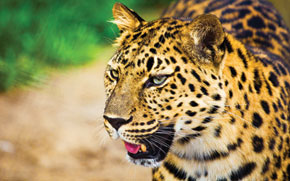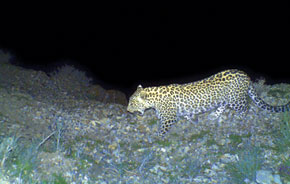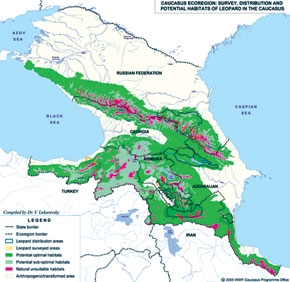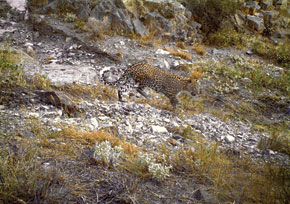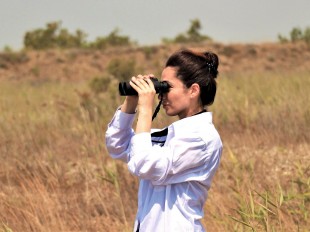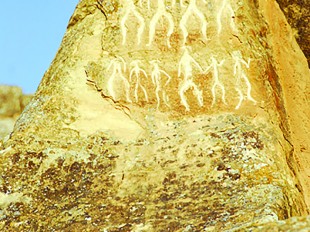This magnificent leopardess was photographed by a trap camera in the early hours of 2 June in Azerbaijan’s Nakhchivan Autonomous Republic. She is a rare Caucasus leopard, one of only a handful known to be living in the region. Elshad Askerov, the World Wildlife Fund’s leopard expert in Azerbaijan, has confirmed to Visions that not one but at least two leopardesses are living in the Hasan Aliyev Zangezur National Park and surrounding areas. He has identified the two big cats by studying the markings on their coats in photographs taken in September 2012 and February, March and June this year.
PANTHERA PARDUS SAXICOLOR
The Caucasus leopard, Panthera pardus saxicolor (also known as Panthera pardus ciscaucasia, the West Asian leopard, Persian leopard and Central Asian leopard), is one of the biggest of the leopard subspecies. Like other leopards, the Caucasus leopard has a stocky body with comparatively short legs and a large head. Its total body length ranges between 125 and 171 cm and weight can reach 60 kg. Male leopards are up to three times larger than their female counterparts. The Caucasus leopard has a soft, furry coat, the base colours of which range from grey-ochre to golden brown. The leopard has black spots on the head, limbs and belly and spots arranged in rosettes across the back and flanks.
Animals reach sexual maturity at the age of two to three years and can live up to 20 years, according to specialists from the World Wide Fund for Nature (WWF) and World Conservation Union. Young leopards become independent at the age of 13–18 months. Siblings may remain together for several months before separating. Adult leopards are solitary animals except when mating or rearing their cubs. They have their own range of territory which can be anything from 8 to 450 km².
Adult males usually live entirely or partially on the territories of two or three adult females, according to Dr Viktor Lukarevsky, a Russian expert who has done a lot of work for the WWF. Since adult males are also more mobile than females and often change their hunting grounds, it is not surprising that the Nakhchivan cameras have so far photographed only females. When the leopardesses are on heat, they actively search for males, intensely marking their territory. In this period, both males and females patrol almost their entire territory or range.
Leopards are mobile animals and choose trails with a good view when moving from one hunting ground to another. Such trails often pass along ridges with panoramic vistas and visibility up to several kilometres. The leopard is one of the swiftest animals in the Caucasus. It can run at more than 60 km/hour, can leap three metres from a standing position and six metres when running. Leopards are also good swimmers.
The Caucasus leopard’s main prey is wild (bezoar) goat, wild boar and roe deer. If the supply is plentiful, then the leopard is highly unlikely to make attacks on domestic animals, but when wild prey is scarce, attacks on cattle, sheep, horses, donkeys, dogs and poultry are reported.
NUMBERS
The leopard used to be widespread throughout the Caucasus. Numbers fell dramatically in the 20th century, largely because of hunting, persecution, trapping and poisoning. By the 1950s and 60s leopards had disappeared from large parts of the eco-region and, with the exception of Iran, their former territorial range had been reduced to isolated patches.
Soviet researchers wrote in 1972 that the Caucasus leopard population was close to the brink of extinction. The same year the authorities included the Caucasus leopard in the Soviet Union’s Red Book of Endangered Species, giving it special protection.
According to the International Union for the Conservation of Nature’s (IUCN’s) Red List of Threatened Species, the total number of Caucasus, Persian or West Asian leopards in 2008 lay between 871 and 1,290. Most of these – between 550 and 850 – were in Iran, while Afghanistan was thought to have 200 to 300 and Turkmenistan 78 to 90. Numbers of the species in the Caucasus itself, however, were much smaller. There were thought to be 10 leopards in the Russian North Caucasus in 2008, five in Georgia, 10 to 13 in Armenia, five in Turkey and 13 to 17 in Azerbaijan, of which three to four were in Nagorno-Karabakh.
Iran is the leopard stronghold in the Middle East and supports the viability of the small leopard subpopulations in the Caucasus, eastern Turkey and, possibly, in Turkmenistan through transboundary emigrations, the IUCN notes. However, leopard densities even in Iran are believed to be very low.
LEOPARDS IN AZERBAIJAN
Leopards live in four different parts of Azerbaijan, according to a 2007 report compiled by experts from the WWF and the IUCN/SSC Cat Specialist Group.
Signs of three to five leopards were identified at an altitude of 700-1500 metres in the Talish Mountains in the south-eastern corner of Azerbaijan. This occurrence is adjacent to the leopard range in the neighbouring ridges of Iran.
Probably no more than three to four leopards were thought to be living in the Zangezur range of the Nakhchivan Autonomous Republic in south-western Azerbaijan. The distribution of leopards here was consistent with their presence in Armenia and Iran, the experts noted. It is in the Zangezur National Park that our two leopardesses have more recently been photographed. Their territorial range probably includes southern Armenia and north-western Iran. The WWF in Armenia is in the process of installing cameras on the Armenian side of the border with Nakhchivan to monitor the progress of these leopards. As they are both young females, conservationists hope that they will find a mate and that the cameras will photograph them soon with one or two cubs.
It was difficult to assess the presence of leopards in the occupied Azerbaijani territory of Nagorno-Karabakh. In 2007, the experts thought that no more than three to four animals lived in the western part of the Karabakh and Murovdagh mountains.
Finally, traces of three to four leopards were also found in the transboundary corridor which covers arid landscapes around the Mingachevir Water Reservoir in Georgia and Azerbaijan. This occurrence in the Greater Caucasus interested the experts because of its potential connection with adjacent leopard areas in Georgia and Russia.
Leopards in the south of Azerbaijan like the steep ravines with old-growth forests (maple, beech, hornbeam, linden, oak, walnut, etc.) and rocky cliffs and outcrops of the Istisuchay valley in the Talish Mountains. Evidence of leopards has been found in areas with good visibility and with high numbers of wild boar and roe deer.
CONSERVATION ACTION
Conservation organization the World Wide Fund for Nature set up a regional office in Tbilisi, Georgia, in 1992 and started projects specifically in Azerbaijan in early 2000. Its Azerbaijani office was officially registered in 2006. One of the Fund’s first and most important ongoing projects in Georgia, Armenia and Azerbaijan is the conservation of leopards.
The WWF hosted a regional workshop in Tbilisi in 2007 to thrash out a comprehensive Conservation Strategy for the leopard in the Caucasus. Wildlife scientists, representatives of agencies from most of the range countries and of conservation organizations developed a vision: Leopards and all wildlife prosper in natural habitats across the Caucasus eco-region in harmony with people.
To achieve the vision, the mid-term goal was set: Ensure the conservation and sustainable management of viable meta-populations of leopard and wild prey and their habitats and build sustainable coexistence mechanisms with local communities across the Caucasus eco-region.
On the basis of the Conservation Strategy, a National Action Plan to preserve the leopard has been drawn up and adopted in Azerbaijan. The action plan is being implemented by the WWF with the cooperation of Azerbaijan’s Ministry of Ecology and Natural Resources. Similar action plans are in place in Armenia and Georgia.
The cameras which photographed our leopardesses in Nakhchivan were installed as part of the National Action Plan in order to monitor the number of leopards and their prey. Scientists from the Institute of Bioresources of the Nakhchivan Branch of the National Academy of Sciences of Azerbaijan, under the supervision of Prof. Tariyel Talibov, helped the WWF with the installation of the cameras in the Zangezur National Park. The cameras caught their first photo of a leopard in June 2012. This caused a sensation, as it was the first actual sighting of a leopard in the area for 50 years.
Trap cameras in the Hirkan (Hyrcan) National Park in the Talish Mountains in the far south of Azerbaijan caught a leopard on film on 13 May this year. This was the third sighting in the park after photos taken in October 2012 and February 2007. Interestingly, these are daytime shots, which implies that the leopard does not feel threatened in the area.
TARGETS
The WWF and IUCN/SSC Cat Specialist Group no longer consider a lack of prey to be the greatest threat to the survival of the Caucasus leopard. The two greatest threats are the fragmentation of the leopard’s habitat, meaning that potential mates are kept apart, and poaching.
The WWF Caucasus Programme Office is concentrating its efforts on reconnecting leopard habitat by providing wildlife corridors. The Fund has set the mid-term goal of ensuring that at least two wildlife corridors are established and well managed in Hirkan National Park and the Akhar-Bakhar section of Ilisu Reserve in northern Azerbaijan by 2016.
The Fund’s goal by 2021 is to have at least one breeding female in each of the four priority areas for leopards in the Caucasus, with total population size exceeding 30 individuals. The priority areas are the South-East Lesser Caucasus (Armenia, Azerbaijan’s Nakhchivan Autonomous Republic), the East Greater Caucasus (the Russian Federation’s Dagestan Republic), the Talish Mountains in the south of Azerbaijan and Iori-Mingachevir in northern Azerbaijan.
Poaching poses a great danger to the conservation of the leopard, as the loss of just one animal can ruin the chances of survival of a small population nucleus. The WWF is supporting governments in their efforts to combat poaching but simply does not have the resources required to enforce anti-poaching legislation.
A boost to the conservation of the leopard came when the organization IDEA (International Dialogue for Environmental Action) declared a Big Five of Caucasian animals in need of protection. They are the Caucasus leopard, wolf, bear, eagle and gazelle.
DON’T BE FOOLED
Efforts to conserve the leopard may be hampered by the popular imagination about the animal and misinformation in the media. Reports that a leopard attacked and dismembered an 18-year-old girl in a village in Lerik District in March were met with laughter and incredulity by villagers, local authorities and the Lerik branch of the Ministry of Ecology and Natural Resources, Gun.Az news agency reported.
Following previous reports of leopard attacks, the Ministry of Ecology and Natural Resources made clear in a 2009 press release that it is very rare for leopards to attack humans. Stressing that leopards avoid human contact, the ministry said that the big cats would attack only if provoked in some way, for example, if shot and wounded by a hunter. The ministry recalled that the penalty for killing a leopard is 3,300 AZN and two or three times that sum for killing a leopard in a protected area.
CRITICALLY ENDANGERED
The leopard in the Caucasus remains critically endangered. The new surveys have produced the spectacular photographs on these pages, but all the latest evidence confirms that only small and isolated population nuclei remain in the whole eco-region. Urgent conservation action is needed to ensure the survival of the species in the Caucasus, the WWF stresses.
The Fund is keen to see significant investment in the conservation of the leopard as: ...this charismatic large cat is both an umbrella species – its conservation will also include the preservation of the prey species and their habitats – and a flagship species – the leopard is the symbolic carrier of the conservation idea to the local population, between the range states, and to the international conservation community.
Text Box
History and Culture
The leopard has a long history on the territory of Azerbaijan. The oldest leopard fossils in the country, some 300-400,000 years old, were found in the Azikh Cave in Nagorno-Karabakh. More recent leopard skulls, from circa 3000 BCE, were found in caves in Qobustan and Agstafa.
The earliest people of this land also left a record of the leopard. The animal is depicted in Stone Age rock drawings in Gamiqaya (Nakhchivan), Kelbajar and Qobustan. The leopard is shown in hunting scenes in Azerbaijani medieval miniatures and, moving west, features even in the title of Georgia’s national epic poem, The Knight in the Panther Skin.
